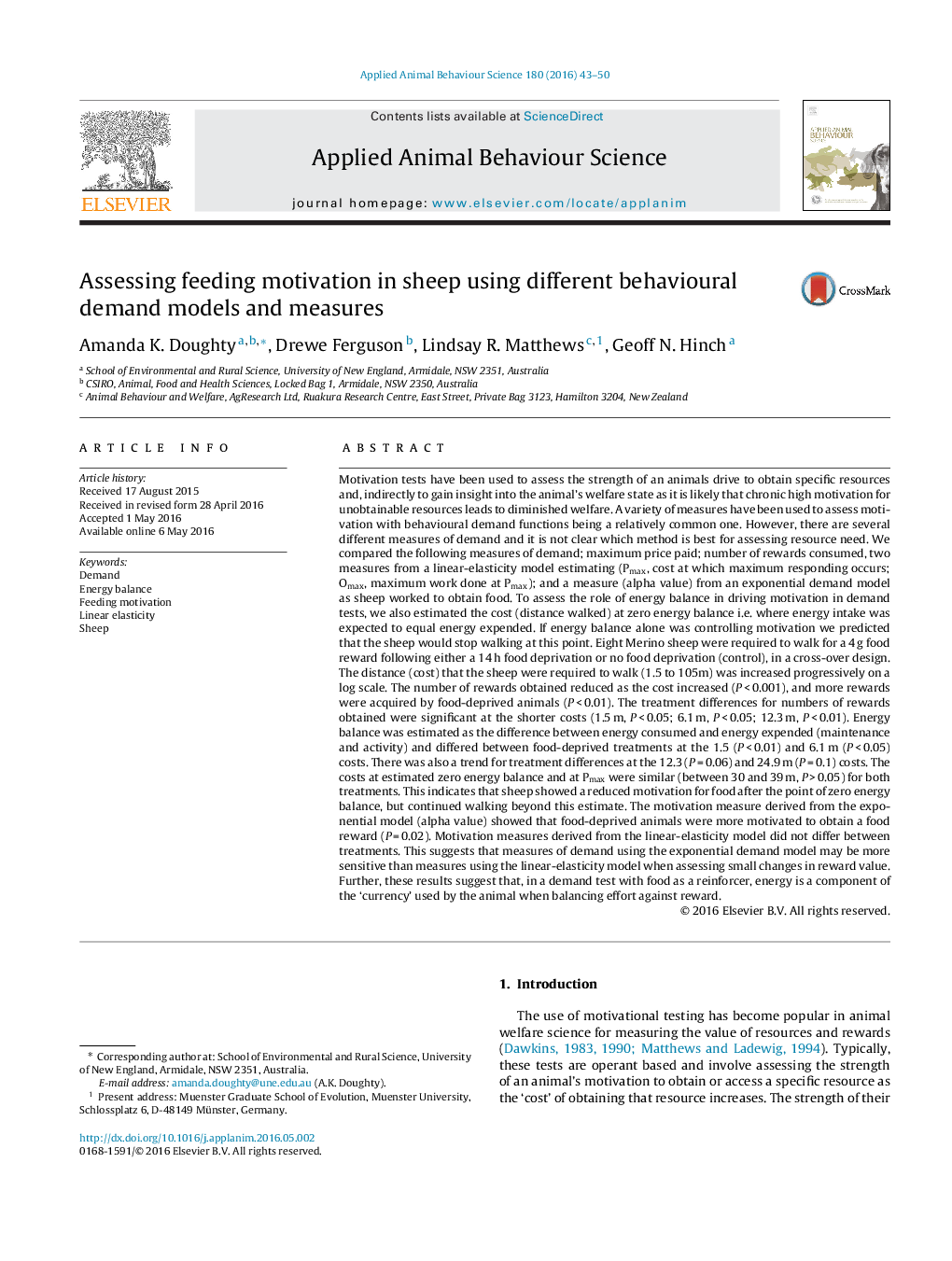| کد مقاله | کد نشریه | سال انتشار | مقاله انگلیسی | نسخه تمام متن |
|---|---|---|---|---|
| 6379247 | 1625326 | 2016 | 8 صفحه PDF | دانلود رایگان |
- We investigated feeding motivation in sheep using different methods of analysis.
- Treatments were 14Â h food deprived versus non-food deprived sheep.
- Motivation measures Pmax and Omax did not differ between treatments.
- Alpha value and number of rewards consumed showed more feeding motivation in deprived sheep.
- Alpha value may be of more use when assessing small changes in reward value.
Motivation tests have been used to assess the strength of an animals drive to obtain specific resources and, indirectly to gain insight into the animal's welfare state as it is likely that chronic high motivation for unobtainable resources leads to diminished welfare. A variety of measures have been used to assess motivation with behavioural demand functions being a relatively common one. However, there are several different measures of demand and it is not clear which method is best for assessing resource need. We compared the following measures of demand; maximum price paid; number of rewards consumed, two measures from a linear-elasticity model estimating (Pmax, cost at which maximum responding occurs; Omax, maximum work done at Pmax); and a measure (alpha value) from an exponential demand model as sheep worked to obtain food. To assess the role of energy balance in driving motivation in demand tests, we also estimated the cost (distance walked) at zero energy balance i.e. where energy intake was expected to equal energy expended. If energy balance alone was controlling motivation we predicted that the sheep would stop walking at this point. Eight Merino sheep were required to walk for a 4Â g food reward following either a 14Â h food deprivation or no food deprivation (control), in a cross-over design. The distance (cost) that the sheep were required to walk (1.5 to 105m) was increased progressively on a log scale. The number of rewards obtained reduced as the cost increased (PÂ <Â 0.001), and more rewards were acquired by food-deprived animals (PÂ <Â 0.01). The treatment differences for numbers of rewards obtained were significant at the shorter costs (1.5Â m, PÂ <Â 0.05; 6.1Â m, PÂ <Â 0.05; 12.3Â m, PÂ <Â 0.01). Energy balance was estimated as the difference between energy consumed and energy expended (maintenance and activity) and differed between food-deprived treatments at the 1.5 (PÂ <Â 0.01) and 6.1Â m (PÂ <Â 0.05) costs. There was also a trend for treatment differences at the 12.3 (PÂ =Â 0.06) and 24.9Â m (PÂ =Â 0.1) costs. The costs at estimated zero energy balance and at Pmax were similar (between 30 and 39Â m, PÂ >Â 0.05) for both treatments. This indicates that sheep showed a reduced motivation for food after the point of zero energy balance, but continued walking beyond this estimate. The motivation measure derived from the exponential model (alpha value) showed that food-deprived animals were more motivated to obtain a food reward (PÂ =Â 0.02). Motivation measures derived from the linear-elasticity model did not differ between treatments. This suggests that measures of demand using the exponential demand model may be more sensitive than measures using the linear-elasticity model when assessing small changes in reward value. Further, these results suggest that, in a demand test with food as a reinforcer, energy is a component of the 'currency' used by the animal when balancing effort against reward.
Journal: Applied Animal Behaviour Science - Volume 180, July 2016, Pages 43-50
